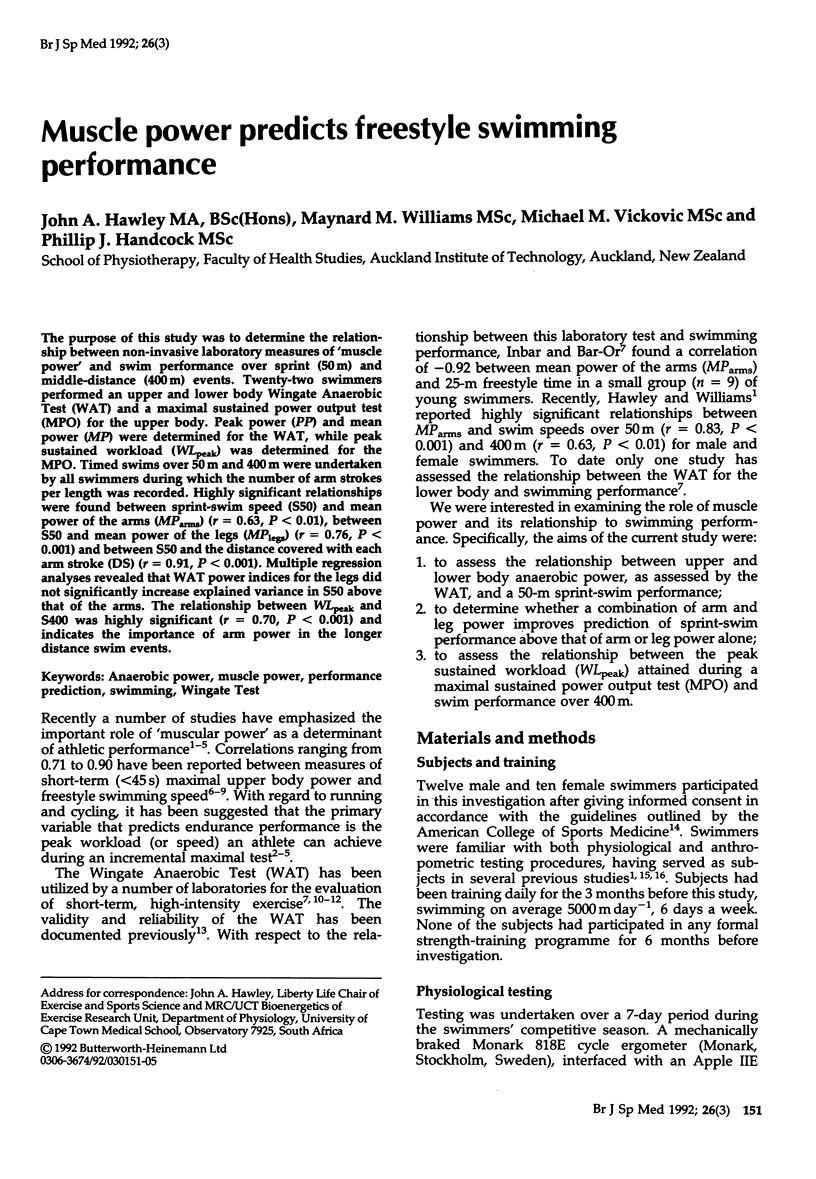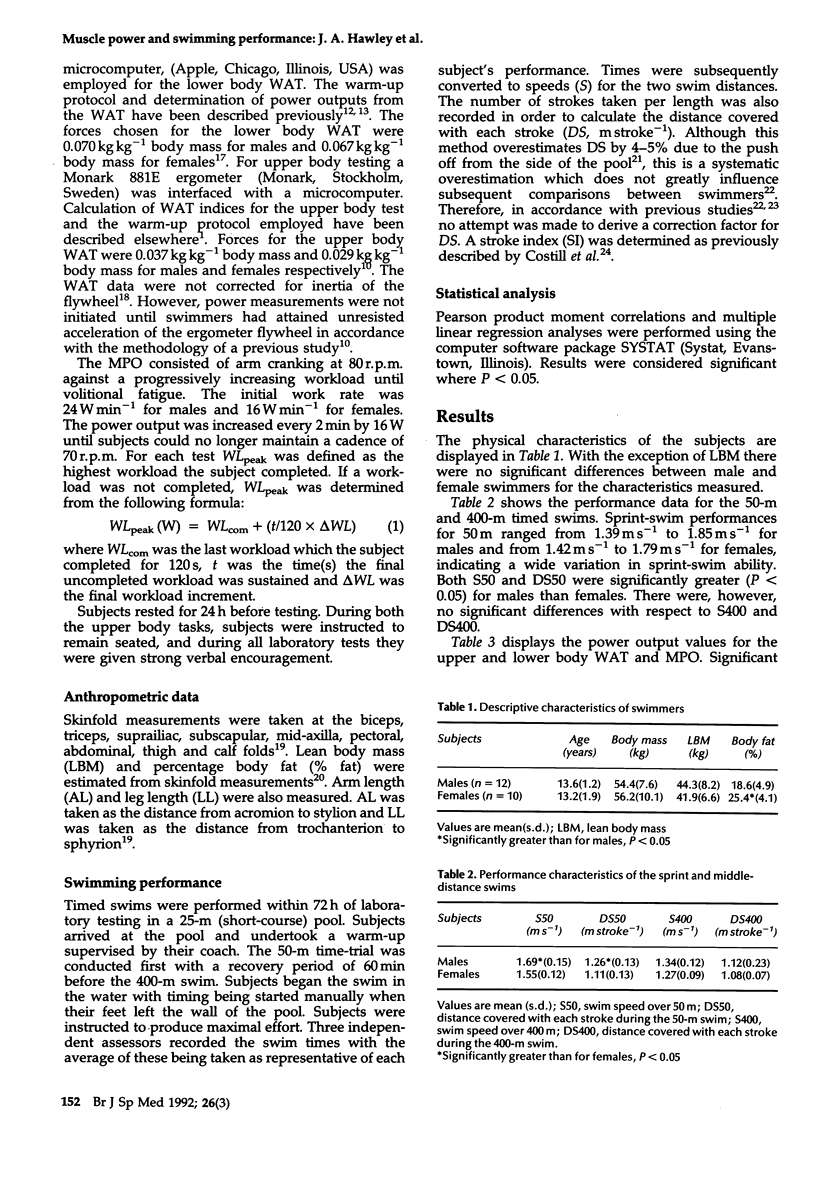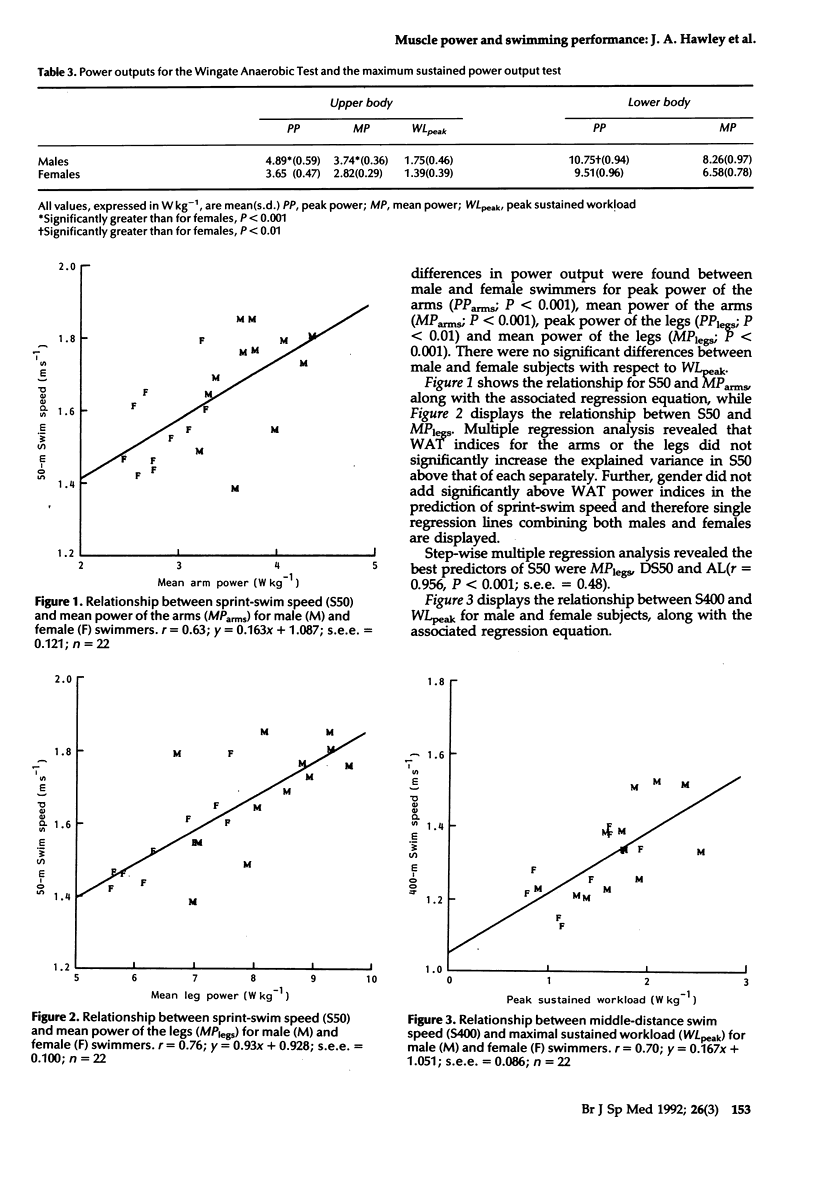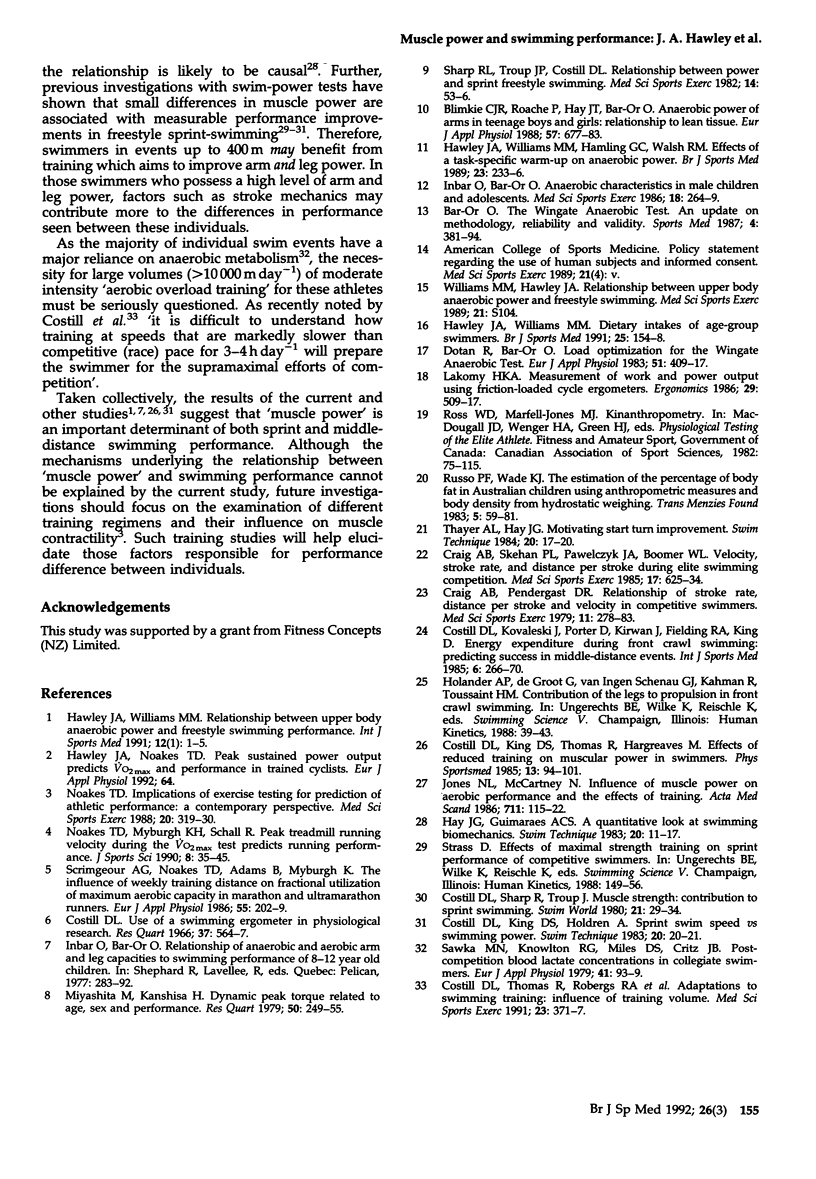Abstract
The purpose of this study was to determine the relationship between non-invasive laboratory measures of 'muscle power' and swim performance over sprint (50 m) and middle-distance (400 m) events. Twenty-two swimmers performed an upper and lower body Wingate Anaerobic Test (WAT) and a maximal sustained power output test (MPO) for the upper body. Peak power (PP) and mean power (MP) were determined for the WAT, while peak sustained workload (WLpeak) was determined for the MPO. Timed swims over 50 m and 400 m were undertaken by all swimmers during which the number of arm strokes per length was recorded. Highly significant relationships were found between sprint-swim speed (S50) and mean power of the arms (MP(arms)) (r = 0.63, P less than 0.01), between S50 and mean power of the legs (MP(legs)) (r = 0.76, P less than 0.001) and between S50 and the distance covered with each arm stroke (DS) (r = 0.91, P less than 0.001). Multiple regression analyses revealed that WAT power indices for the legs did not significantly increase explained variance in S50 above that of the arms. The relationship between WL(peak) and S400 was highly significant (r = 0.70, P less than 0.001) and indicates the importance of arm power in the longer distance swim events.
Full text
PDF




Selected References
These references are in PubMed. This may not be the complete list of references from this article.
- Bar-Or O. The Wingate anaerobic test. An update on methodology, reliability and validity. Sports Med. 1987 Nov-Dec;4(6):381–394. doi: 10.2165/00007256-198704060-00001. [DOI] [PubMed] [Google Scholar]
- Blimkie C. J., Roache P., Hay J. T., Bar-Or O. Anaerobic power of arms in teenage boys and girls: relationship to lean tissue. Eur J Appl Physiol Occup Physiol. 1988;57(6):677–683. doi: 10.1007/BF01075988. [DOI] [PubMed] [Google Scholar]
- Costill D. L., Kovaleski J., Porter D., Kirwan J., Fielding R., King D. Energy expenditure during front crawl swimming: predicting success in middle-distance events. Int J Sports Med. 1985 Oct;6(5):266–270. doi: 10.1055/s-2008-1025849. [DOI] [PubMed] [Google Scholar]
- Costill D. L., Thomas R., Robergs R. A., Pascoe D., Lambert C., Barr S., Fink W. J. Adaptations to swimming training: influence of training volume. Med Sci Sports Exerc. 1991 Mar;23(3):371–377. [PubMed] [Google Scholar]
- Costill D. L. Use of a swimming ergometer in physiological research. Res Q. 1966 Dec;37(4):564–567. [PubMed] [Google Scholar]
- Craig A. B., Jr, Pendergast D. R. Relationships of stroke rate, distance per stroke, and velocity in competitive swimming. Med Sci Sports. 1979 Fall;11(3):278–283. [PubMed] [Google Scholar]
- Craig A. B., Jr, Skehan P. L., Pawelczyk J. A., Boomer W. L. Velocity, stroke rate, and distance per stroke during elite swimming competition. Med Sci Sports Exerc. 1985 Dec;17(6):625–634. doi: 10.1249/00005768-198512000-00001. [DOI] [PubMed] [Google Scholar]
- Dotan R., Bar-Or O. Load optimization for the Wingate Anaerobic Test. Eur J Appl Physiol Occup Physiol. 1983;51(3):409–417. doi: 10.1007/BF00429077. [DOI] [PubMed] [Google Scholar]
- Hawley J. A., Williams M. M. Dietary intakes of age-group swimmers. Br J Sports Med. 1991 Sep;25(3):154–158. doi: 10.1136/bjsm.25.3.154. [DOI] [PMC free article] [PubMed] [Google Scholar]
- Hawley J. A., Williams M. M., Hamling G. C., Walsh R. M. Effects of a task-specific warm-up on anaerobic power. Br J Sports Med. 1989 Dec;23(4):233–236. doi: 10.1136/bjsm.23.4.233. [DOI] [PMC free article] [PubMed] [Google Scholar]
- Hawley J. A., Williams M. M. Relationship between upper body anaerobic power and freestyle swimming performance. Int J Sports Med. 1991 Feb;12(1):1–5. doi: 10.1055/s-2007-1024645. [DOI] [PubMed] [Google Scholar]
- Inbar O., Bar-Or O. Anaerobic characteristics in male children and adolescents. Med Sci Sports Exerc. 1986 Jun;18(3):264–269. doi: 10.1249/00005768-198606000-00002. [DOI] [PubMed] [Google Scholar]
- Jones N. L., McCartney N. Influence of muscle power on aerobic performance and the effects of training. Acta Med Scand Suppl. 1986;711:115–122. doi: 10.1111/j.0954-6820.1986.tb08939.x. [DOI] [PubMed] [Google Scholar]
- Lakomy H. K. Measurement of work and power output using friction-loaded cycle ergometers. Ergonomics. 1986 Apr;29(4):509–517. doi: 10.1080/00140138608968287. [DOI] [PubMed] [Google Scholar]
- Miyashita M., Kanehisa H. Dynamic peak torque related to age, sex, and performance. Res Q. 1979 May;50(2):249–255. [PubMed] [Google Scholar]
- Noakes T. D. Implications of exercise testing for prediction of athletic performance: a contemporary perspective. Med Sci Sports Exerc. 1988 Aug;20(4):319–330. doi: 10.1249/00005768-198808000-00001. [DOI] [PubMed] [Google Scholar]
- Noakes T. D., Myburgh K. H., Schall R. Peak treadmill running velocity during the VO2 max test predicts running performance. J Sports Sci. 1990 Spring;8(1):35–45. doi: 10.1080/02640419008732129. [DOI] [PubMed] [Google Scholar]
- Sawka M. N., Knowlton R. G., Miles D. S., Critz J. B. Post-competition blood lactate concentrations in collegiate swimmers. Eur J Appl Physiol Occup Physiol. 1979 May 18;41(2):93–99. doi: 10.1007/BF00421656. [DOI] [PubMed] [Google Scholar]
- Scrimgeour A. G., Noakes T. D., Adams B., Myburgh K. The influence of weekly training distance on fractional utilization of maximum aerobic capacity in marathon and ultramarathon runners. Eur J Appl Physiol Occup Physiol. 1986;55(2):202–209. doi: 10.1007/BF00715006. [DOI] [PubMed] [Google Scholar]
- Sharp R. L., Troup J. P., Costill D. L. Relationship between power and sprint freestyle swimming. Med Sci Sports Exerc. 1982;14(1):53–56. doi: 10.1249/00005768-198201000-00010. [DOI] [PubMed] [Google Scholar]


